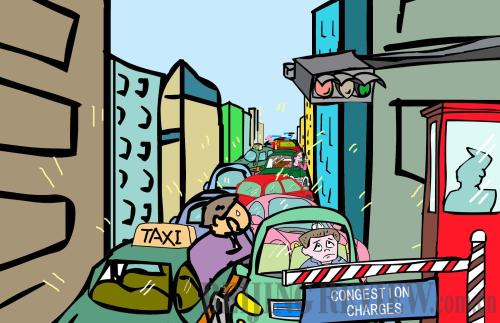|
 |
|
(LI SHIGONG) |
A recent proposal by Qiu Baoxing, Vice Minister of Housing and Urban-Rural Development, to alleviate Beijing's traffic jams has triggered heated debate among the public.
Beijing has 20 million people and 4.2 million vehicles, a fleet growing by 500,000 each year, Qiu wrote. Since most of the city's business districts, administrative offices, financial institutions and first-class hospitals are located in the city center, he warned conventional methods would be insufficient to curb congestion in downtown areas due to explosive growth of traffic flow there.
Besides raising parking fees in city center and improving the management of bus-only lanes, congestion pricing should be introduced, Qiu said. He also suggested scrapping highway tolls to encourage residents in city center to move to satellite cities.
Shi Qixin, professor at the Institute of Transportation Engineering of Beijing-based Tsinghua University, said the international standard for introducing congestion charges was when the degree of saturation of roads reached 85 percent and the average speed of vehicles traveling on roads was below 18 km per hour. Shi said big cities like Beijing were close to that standard.
People opposing the introduction of congestion pricing said the precondition for collecting congestion charges was convenient public transport systems in place. However, Beijing formulated plans to develop a large rail transportation system as recently as 2004 and public transportation in downtown Beijing is still not "convenient." In these circumstances, levying congestion charges would force some car owners, especially commuters, to switch to public transportation, which could give rise to new problems such as overcrowding on public transportation.
Several cities in China have studied the feasibility of levying congestion charges amid worsening urban traffic jams. But no city has introduced them yet.
Guangzhou, a city in south China, opened public discussion on whether to introduce congestion charges earlier this year. But an online survey conducted by Guangzhou Daily and news portal Sina.com found 84.4 percent of respondents opposed the charges and 5.4 percent could "conditionally support them, depending on where the charge zone is."
Not a panacea
Lou Yihua (www.qianlong.com): To ease traffic jams, Beijing has banned some vehicles from the road for one day a week based on their plate numbers. This policy has proved effective. Moreover, many car owners have acknowledged the fairness of the policy. But the measure of pulling some cars off roads would outlive its effectiveness in big cities such as Beijing considering the explosive growth of the number of new cars and limited public resources.
If the policy of ordering vehicles off the road according to their plate numbers was revoked and congestion pricing was introduced, the city would have one more revenue source but the traffic congestion wouldn't be alleviated. Many cars on the roads in Beijing belong to government departments and agencies, which don't mind paying congestion charges for using their publicly funded cars. The introduction of congestion pricing would only end up forcing some private car owners to switch to public transportation.
Qiu is following the practice started by London. But, after congestion pricing was introduced in 2003, London's congestion level in 2006 was the same as that of 2003 and serious congestion reappeared in 2009, according to latest statistics. Therefore, congestion pricing might not be the best solution to urban traffic jams in the long run.
Charging car owners fees or limiting the use of cars alone are not sufficient for the management of urban traffic. A mix of measures must be adopted, such as promoting a low-carbon life, reducing the number of publicly funded cars and continuing improving public transport to satisfy people's demands.
Chun Hua (Modern Express): It seems the proposal to introduce congestion charges and scrap highway tolls aims to lure low-income residents to move from city proper to suburban areas. Vice Minister Qiu regards congestion pricing as a miracle recipe for traffic jams and, like many other officials and experts sharing the belief, substantiated its effectiveness with the "pioneering experience" of London.
Why do proponents of congestion pricing keep on bringing forward the "success stories" of London and Singapore? Because they are the only two cities that ever levied congestion charges. There are hundreds of thousands of cities in the world. Can two cities' practices prove the universality of a policy? Moreover, even London authorities themselves have admitted the congestion charges failed to deliver the expected results.
In China, downtown areas in big cities like Beijing have the best public resources and people are scrambling for them. Compared with paying congestion charges, the costs of moving from the city proper to a satellite city are much higher.
As economic leverage to adjust the traffic flow, congestion pricing shouldn't be put on the table unless all other possible means to reduce traffic jams have been implemented. For example, what we can do now is to reduce the number of official cars and build a public transportation system that is as convenient as that in Singapore. If these two measures are not taken before introducing congestion charges, the government will be blamed for "helping the rich at the cost of the poor."
Wang Gangyi (Legal Daily): Although the vehicle fleet has been growing along with worsening traffic conditions, it is not the only culprit. We should not blame mostly the owners of private cars. The main cause is urban administration cannot keep up with the speed of urban development. If officials refuse to be self-critical and find solutions inside themselves, their proposals must be one-sided and flawed.
| 